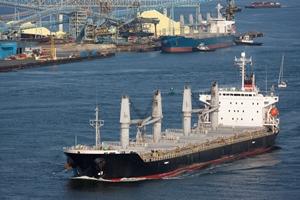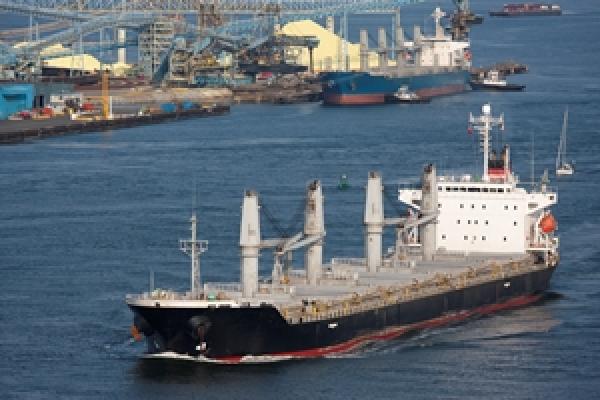
Steamship Mutual
Published: November 01, 2013

Disputes regularly arise where the quantity of cargo discharged from a vessel does not correspond to the bill of lading’s figures. While it is more common that these discrepancies refer to shortlandings, a tribunal was recently asked to consider the position where the reverse occurred and cargo in excess of that stated on the bill of lading was discharged. The question formed part of a counterclaim raised by charterer of a vessel in response to proceedings brought against them by owners for outstanding sums said to be due.
The vessel had fixed to carry 50,000mt of corn in bulk, 10% more or less in charterer’s option, from Brazil to one or two safe ports in Indonesia. On July 13th 2011 following the completion of loading, mates’ receipts were signed by the master. The mates’ receipts reflected figures recorded as per the shore scales which suggested 50,299.983mt of cargo had been loaded. On the same day, four separate draft surveys took place that indicated that in fact a figure of between 767.017 and 781.236mts additional cargo had been loaded than the figures produced by the shore scales and recorded on the mates’ receipts.
Prior to sailing on July 14th, the master issued a note of protest over the discrepancies but addressed it only to the port agents and shippers. Charterers contended that they did not receive this protest until after clean bills of lading had been issued with the shore scale figures.
Although the mates’ receipts had been qualified with the phrases “said to be” and “quality, quantity, weight, measure, condition, contents and value unknown”, no remarks were entered onto them regarding the discrepancy between the shore figures and the draft surveys. The issued bills of lading mirrored the qualifications on the mates’ receipts and were similarly silent on the discrepancies.
Several other points of dispute were brought before the tribunal, but in summary the claim advanced by owners was for a final hire balance of US$140,148.21 plus US$10,000 for the cost of replacing the hoisting wire at the first discharge port and US$5,790.07 for a bunker adjustment on redelivery based on a margin of 2%.
In response, charterers denied that the final hire balance was correct and sought to set off by way of a counterclaim, the sum of US$34,710 which represented freight they would have earned had the mates’ receipts and bills of lading been issued to reflect the draft survey figures for cargo loaded.
The tribunal found for charterers in respect of the claim for lost freight. They held that the discrepancy between the shore scale figures and the draft surveys was significant as it was in excess of 1% of the cargo recorded as having been loaded on board the vessel. The master knew of the discrepancy as evidenced by the letter of protest issued and consequently the tribunal did not accept that he did all he reasonably could to protect charterer’s position. As soon as the master was aware of the discrepancy following the draft surveys on January 13th, direct contact should have been made with charterers to advise them so that instructions could have been obtained before the mates’ receipts were signed.
The tribunal accepted charterers’ argument that the owners were in breach of clause 7 of the charterparty – “That the whole reach of the vessel’s Hold, Decks, and usual places of loading (not more than she can reasonable [sic] stow and carry) …” – because the under-recording of the cargo loaded effectively prevented the “whole reach” of the vessel being available for their use. As a result of loading extra cargo, charterers were prevented from utilising the vessel’s full capacity. A concurrent argument that under clause 8 – “That the captain shall … render all customary assistance with the ship’s crew and boats. The Captain (although appointed by the Owners), shall be under the orders and directions of the Charterers as regards employment and agency; and Charterers are to load, stow, secure, discharge, lash, unlash, dunnage, undunnage, and secure and tally and trim the cargo at their expense under the supervision of the Captain, who is to sign or when required by Charterers by their agents to sign on his behalf bills of lading for cargo as presented, in strict conformity with Mate’s receipts” – owners failed to “render all customary assistance” was also upheld. That is, there was a failure to follow instructions that should have been obtained from charterers when the discrepancy on the loaded quantity was known.
Also of note was owner’s failed argument based on clause 8 of the charter – that charterers were responsible for loading operations and therefore should be responsible for any mistake by the terminal as to the quantities loaded. Similarly, owners were unable to rely on Article III, Rule 5 of the Hague-Visby Rules, which were incorporated into the charter. Rule 5 provides:
“The Shipper shall be deemed to have guaranteed to the carrier the accuracy at the time of shipment of the marks, number, quantity and weight, as furnished by him, and the shipper shall indemnify the carrier against all loss, damages and expenses arising or resulting from inaccuracies in such particulars ...”
Owners had argued that the word “shipper” in Article III Rule 5 should be construed as a reference to the charterer, and as a consequence, charterer had guaranteed the accuracy at the time of shipment of quantity loaded. However, the tribunal decided that any such “guarantee” could not apply when the master had actual knowledge of a discrepancy, and in any event Rule 5 was designed to protect owner, as the signatory of the bill of lading, against claims brought under the bill of lading by shipper or consignee.
Accordingly, charterer’s counterclaim for deadfreight was successful.
The case serves to illustrate the importance of accurate bill of lading figures and demonstrates that it is not only shortages that can result in owners facing claims. Furthermore, where a master becomes aware of an issue such as this it is important that a dialogue with owners, and if required the club, is established so that proper instructions are obtained from the vessel’s charterers in order to mitigate any potential claims.
While the focus of this article is on the master’s failure to sign accurate mates’ receipts resulting in cargo in excess of the bill of lading quantities being carried, owners did succeed on the bunker allowance claim.
Charterers relied on a decision in London Arbitration 13/03: where a margin of 5% was permitted as accurate, redelivery figures were not always possible to ascertain. The facts in the present case differed; 12 days before redelivery owners advised charterers that 113mt IFO would be required. Although owners had informed them of the quantities needed, charterers only stemmed 95mt IFO at the last discharge port before redelivery. Contrary to the facts of London Arbitration 13/03, charterers had no difficulty in ascertaining the quantities needed. As such, the tribunal was reluctant to allow an absolute acceptance of a shortfall of 5% across the board as it would likely result in a situation where charterers would routinely try to save costs by redelivering with a 5% shortfall.


